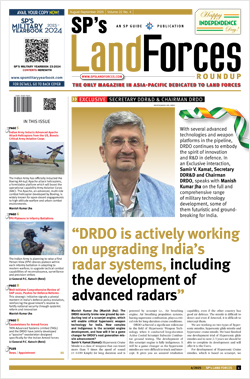INDIAN ARMED FORCES CHIEFS ON OUR RELENTLESS AND FOCUSED PUBLISHING EFFORTS

The insightful articles, inspiring narrations and analytical perspectives presented by the Editorial Team, establish an alluring connect with the reader. My compliments and best wishes to SP Guide Publications.

"Over the past 60 years, the growth of SP Guide Publications has mirrored the rising stature of Indian Navy. Its well-researched and informative magazines on Defence and Aerospace sector have served to shape an educated opinion of our military personnel, policy makers and the public alike. I wish SP's Publication team continued success, fair winds and following seas in all future endeavour!"

Since, its inception in 1964, SP Guide Publications has consistently demonstrated commitment to high-quality journalism in the aerospace and defence sectors, earning a well-deserved reputation as Asia's largest media house in this domain. I wish SP Guide Publications continued success in its pursuit of excellence.
- Appointments Committee of Cabinet approves one-month extension in service of Chief of the Army Staff
- Prime Minister witnesses 'Bharat Shakti' – a Tri-Services Firing and Manoeuvre Exercise in Pokhran, Rajasthan
- Interim Defence Budget 2024-25 — An Analysis
- Union Defence budget 2024
- Indian Army: In quest of greater firepower and policy recommendations for gaps
- Indian Army Annual Press Conference 2024
- Tata Boeing Aerospace Delivers 250 AH-64 Apache Fuselages, Manufactured in India
Exercise Shoorveer Ends
By SP's Special Correspondent
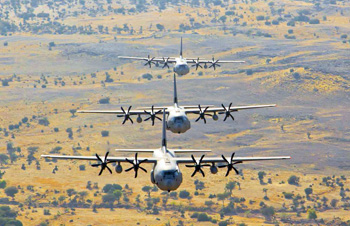
Hercules C-130J aircraft practicing low level tactical
formation over desert of Rajasthan in preparation for
'Exercise Shoorveer'
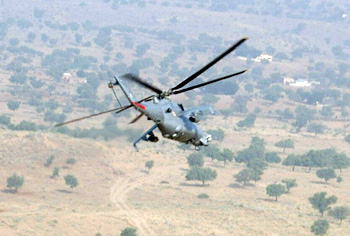
Mi-35 attack helicopter overflying a column of tanks during
'Exercise Shoorveer'
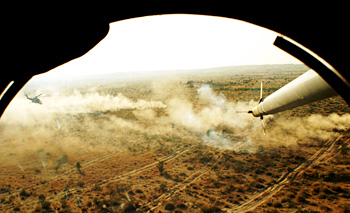
Mi -35 attack helicopter seen in action during
'Exercise Shoorveer'
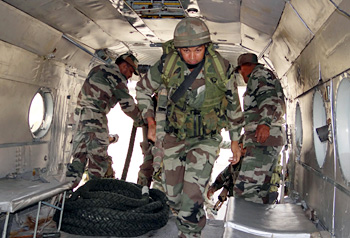
Mi-17 helicopter carrying troops in 'Exercise Shoorveer'
May 09, 2012: The Indian Army and Air Force have just completed one of their most complex integrated theatre battle concept exercises in the deserts of Rajasthan, Exercise Shoorveer. With the elite 1 Strike Corps in the lead, supported by the Chetak Corps and all other relevant elements of South Western Army command, the formations tested brand new battle fighting concepts and doctrines with heavyduty real time images of the battle zone beamed to a centralised command and control centre from platforms that included fighter jets, unmanned aerial vehicles (UAV) and attack helicopters, all coming together to wage war in network centric environment. The exercise included massed tank drills backed by long range artillery guns. More than 300 combat vehicles including main battle tank T-90, T-72, long-range 150 mm artillery guns, multi barrel rockets and about 60,000 troops in Shoor Veer.
A standout feature of the exercise was the integrated air-land war-fighting machinery and the synergy between the Indian Army and IAF, which fielded its Sukhoi-30 MKI, MiG-29, MiG-21 Bison, Cheetah, Chetak and Mi-25 attack helicopters. Tactical transports like the new C-130Js and upgraded An-32s also took part in the exercise. The air doctrine being tested is based on the supposition that counter surface force operations are crucial to the overall success of the land operations. The IAF's Mi-17s engaged in Special Heliborne Operations (SHBO). The combat support role involved airborne assault operations, where a large number of paratroopers were para-dropped into the operational area during the exercise.
This was the final theatre concept exercise based on a transformational study of the Indian Army pioneered by Army Chief General V.K. Singh. It was the final exercise he witnesses before retiring at the end of May. The concepts introduced in his study were based on organisational structures and absorption of new age technologies, particularly in the fields of precision munitions, advanced surveillance system, space and network-centricity.
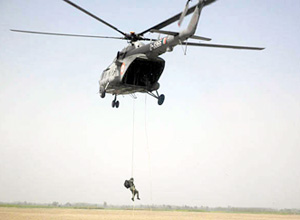
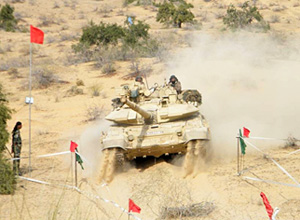
Mi-17 helicopter in 'Exercise Shoorveer'
Armoured Assault using T-90 during
'Exercise Shoorveer'
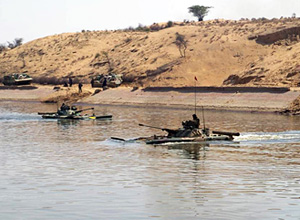
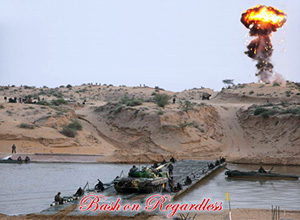
T-90 and T-72 tanks during the Exercise
An Indian Army tank in action
 |
||||||||
| Hercules C-130J aircraft practicing low level tactical formation over desert of Rajasthan in preparation for 'Exercise Shoorveer' |
||||||||
 |
||||||||
| Mi-35 attack helicopter overflying a column of tanks during 'Exercise Shoorveer' |
||||||||
 |
||||||||
| Mi -35 attack helicopter seen in action during 'Exercise Shoorveer' |
||||||||
 |
||||||||
| Mi-17 helicopter carrying troops in 'Exercise Shoorveer'
May 09, 2012: The Indian Army and Air Force have just completed one of their most complex integrated theatre battle concept exercises in the deserts of Rajasthan, Exercise Shoorveer. With the elite 1 Strike Corps in the lead, supported by the Chetak Corps and all other relevant elements of South Western Army command, the formations tested brand new battle fighting concepts and doctrines with heavyduty real time images of the battle zone beamed to a centralised command and control centre from platforms that included fighter jets, unmanned aerial vehicles (UAV) and attack helicopters, all coming together to wage war in network centric environment. The exercise included massed tank drills backed by long range artillery guns. More than 300 combat vehicles including main battle tank T-90, T-72, long-range 150 mm artillery guns, multi barrel rockets and about 60,000 troops in Shoor Veer.
A standout feature of the exercise was the integrated air-land war-fighting machinery and the synergy between the Indian Army and IAF, which fielded its Sukhoi-30 MKI, MiG-29, MiG-21 Bison, Cheetah, Chetak and Mi-25 attack helicopters. Tactical transports like the new C-130Js and upgraded An-32s also took part in the exercise. The air doctrine being tested is based on the supposition that counter surface force operations are crucial to the overall success of the land operations. The IAF's Mi-17s engaged in Special Heliborne Operations (SHBO). The combat support role involved airborne assault operations, where a large number of paratroopers were para-dropped into the operational area during the exercise. This was the final theatre concept exercise based on a transformational study of the Indian Army pioneered by Army Chief General V.K. Singh. It was the final exercise he witnesses before retiring at the end of May. The concepts introduced in his study were based on organisational structures and absorption of new age technologies, particularly in the fields of precision munitions, advanced surveillance system, space and network-centricity.
|





